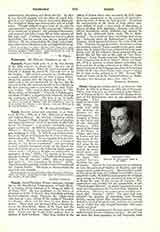

Tasso, TORQUATO, Italian poet, b. at Sorrento near Naples in 1544; d. at Rome, in 1595; son of Bernardo Tasso, who was also an author and of noble family, and of Porzia de Rossi. He enriched the Italian literature of the Renaissance with an epic glorifying the Crusades. The depth of his Catholic feeling accords well with the growing resistance t o the Reformation developed at Rome in the latter half of the sixteenth century. Educated at the Court of the Dukes of Urbino and later at Venice and the University of Padua, and soon carried away by the whirl of frivolous society, he manifested great precocity, composing his poem “Rinaldo” before reaching the age of twenty. Already he had determined to celebrate in verse the prowess of Godfrey de Bouillon, and had composed the entire first canto. When he had settled at Ferrara in the suite of Cardinal Louis d’Este, he resumed the work. In 1570 he accompanied the cardinal on a voyage to France, and returned in time to hear at Rome the news of the victory of Lepanto. The atmosphere was suitable for the composition of the “Gerusalemme liberata”, on which Tasso continued to work after his return to the Court of Duke Alphonso II at Ferrara. Moreover he composed an excellent pastoral idyl, “Aminta” (1573). The poet had now adopted the practice of consulting some learned friends, among others Msgr. Scipio Gonzaga, on the definitive form of his great work, and was very careful not to violate the rules of good literature then commonly accepted.
After 1575, in addition to his literary anxieties, Tasso suffered from intense religious scruples. His life had not been free from reproach; he had frequently been carried away by the storms of passion, and now he became an almost helpless victim of remorse of conscience. He was tormented by the thought of the liberties he had allowed himself in his poems, and consulted the inquisitors. Months of painful doubt followed, with happily a little respite which allowed him to complete his work, some dangerous passages of which he wished to justify by allegorical interpretation. In 1587 his anxieties returned with increased intensity. Court life became unsuitable for him under the circumstances. He began to travel and left Duke Alphonso, but only temporarily, for he returned a prey to a kind of mania about persecution which induced the duke, who had lost patience, to send him to St. Anne’s lunatic asylum. The publication of the “Gerusalemme liberata” was undertaken by his friends Angelo Ingegneri and Febo Bonna, the latter working almost in accordance with the wishes of the poet. When at length Tasso left the asylum and was received by the Gonzaga, he began about 1586 to revise his poem and after six years he transformed it into the “Gerusalemme conquistata”, an inferior work. It was, however, more satisfactory to certain critics, who had taken umbrage at the “Gerusalemme liberata”. Finally, accepting the invitation of Cardinal Aldobrandini, Tasso went to Rome, where he died in the Convent of Sant’ Onofrio, under the protection of the pope, the day before he was to be crowned as poet laureate.
GIUSEPPE GALLAVRESI

